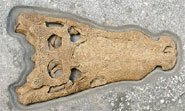The specimen has been given the name Goniopholis kiplingi after Rudyard Kipling, author of The Just So Stories, in recognition of his enthusiasm for the natural sciences.
The skull was discovered in April 2009 by Richard Edmonds, Earth Science Manager with the Jurassic Coast World Heritage Site Team, in the course of regular site monitoring.
After obtaining the necessary permissions from Natural England and Swanage Town Council, it was excavated by Richard with local collectors Steve Etches and Chris Moore and then carefully prepared, by Chris and Alex Moore in their workshop at Charmouth with funding from the Jurassic Coast Trust.
It soon became apparent that this stunning specimen was something of very considerable scientific interest and, as a result, it was loaned to the University of Bristol where PhD student, Marco Brandalise de Andrade carefully studied and compared it to known specimens from all over the world.
Additional preparation was undertaken at Bristol by Remmert Schouten and a CT scan made in order to be able to study structures contained deep within the fossil. As a result of that work, the new identification has been accepted and published in the Zoological Journal of the Linnean Society.
Richard Edwards said: “Despite over 200 years of collecting, specimens new to science continue to be found on this eroding coastline and they always will. The fossil record is far from complete and the chance of a creature such as this being fossilised is very slim. As a result, people will still be making new discoveries 200 years from now.”
Professor Mike Benton from the University of Bristol, co-author of the paper, said: “This stunning specimen shows that there's plenty of life in the Dorset Jurassic – these must be some of the most heavily collected rocks in the world, and yet it’s wonderful to see a new species coming out.
“On a damp, wintry day in Swanage, we have to imagine a world of lush tropical trees, balmy hot lagoons, and crocodiles of all sizes swimming and snapping lazily at dinosaurs on the sea shore.”
The specimen has been donated to the Dorset County Museum by the landowner, Swanage Town Council and Dorset County Council, and is now on display alongside a very much larger Pliosaur skull. A cast forms part of the interpretation in the newly refurbished Durlston Castle Centre at Swanage.
Paper
‘A new Berriasian species of Goniopholis (Mesoeucrocodylia, Neosuchia) from England, and a review of the genus’ by Marco Brandalise de Andrade, Richard Edmonds, Michael J Benton and Remmert Schouten in the Zoological Journal of the Linnean Society
